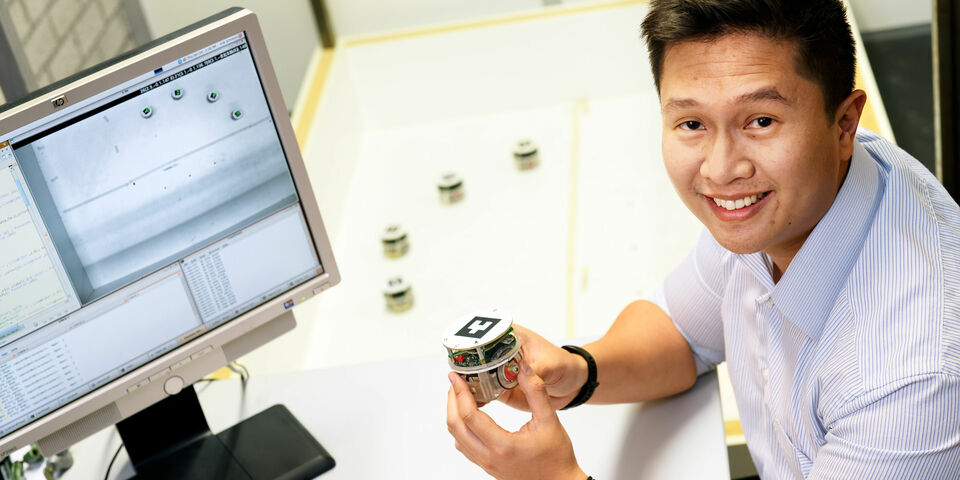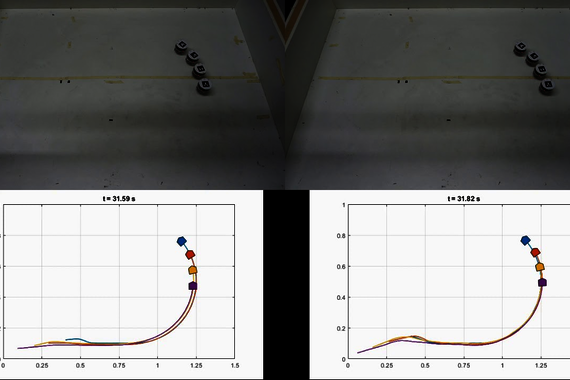Home Stretch | Cars as train wagons
A realistic first step en route to a future populated with self-driving vehicles would seem to be having the vehicles - communicating with each other - drive in single file. Doctoral candidate Anggera Bayuwindra devised a way of preventing the trailing cars in any such platoon inadvertently cutting corners.
When you join the highway in future, your car will probably merge with a column of vehicles without any help from you, steered in the right direction by radar and using wireless communication. As the attention of these electronic resources never wanes, cars can be packed more tightly nose to tail, like virtually-connected wagons in a train - thus reducing fuel consumption and, above all, causing fewer traffic jams. On quiet roads, trucks in this formation are close to being a reality, as recent experiments with what is known as Cooperative Adaptive Cruise Control (CACC) have shown.
On a straight road, CACC - which in fact autonomously determines the car's speed - may already work just fine, but on winding routes additional technology is needed to manage the sideways movement, doctoral candidate Anggera Bayuwindra points out. “When a car bases its steering entirely on the car in front, it will be inclined to cut corners, and that is obviously dangerous.” Just imagine a long truck and a sharp bend, he explains. “The driver has to take the bend wide to avoid a mishap. You can think of a platoon as a very long truck, so the potential problem in the bends is considerable.”
Virtual vehicle
In view of this, CACC tends to be combined at present with a system that keeps the car on course based on the road markings, but these are not always clearly visible - and in some places, such as junctions, may be lacking entirely. “In heavy traffic it is often difficult to detect even good road markings,” says Bayuwindra. “And in a platoon, of course, the vehicles are traveling close together.”
This Indonesian researcher therefore devised an alternative system: the cars follow not the real car in front, but a virtual vehicle, whose position depends on the curvature of the road - the sharper the bend, the further sideways of the real leader this virtual leader is located. The position of this target is calculated based on the steering direction of the actual car in front and is transmitted by a wireless signal to the car behind. Which necessitates communication between the vehicles (and actually accounts for the use of the word ‘cooperative’ in CACC).
This doctoral candidate tested his algorithms using E-pucks, small, mobile robots the size of a coffee mug, which he had driving around in trains of four, first in a circle, and later in a figure eight. “Since in a figure eight, the steering angle changes constantly,” he explains. “Which makes this a good test case.” The route was programmed into the lead robot, but the other E-pucks followed the robot immediately in front of them. The results clearly show that the robots following the 'virtual vehicle’ constructed by Bayuwindra tracked the robot in front of them much more closely without cutting corners- exactly as he intended.
The real world is a little more complex; out on the road you also have to take account of the length and width of each vehicle, so as an initial step Bayuwindra suited his method to a simplified model of vehicles, called a single-track model, where the dynamics of tires are taken into account. “Provided the bends are not too sharp, this is enough to give a good approximation of four-wheeled vehicles,” he says. “Obviously the next step is to run tests on the road with, say, trucks.” A follow-up to the Grand Cooperative Driving Challenge held in 2016 on the A270 between Helmond and Eindhoven would create the ideal opportunity, says Bayuwindra, but nothing like this is planned yet.
In any event, after taking his doctorate, Bayuwindra hopes to do something here in the region with the expertise he has acquired. “This type of research is being done at DAF and TNO, and I expect that in five to ten years' time the technology enabling semi-autonomous driving in a platoon will at least be built into all new cars. It really is a promising approach.”



Discussion